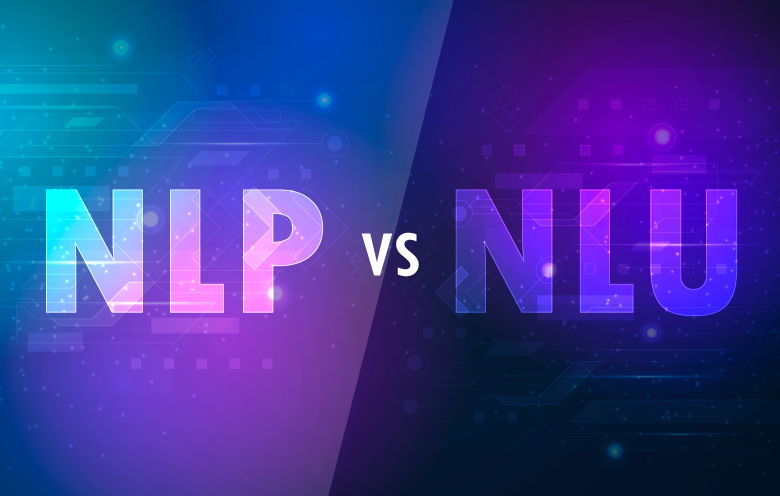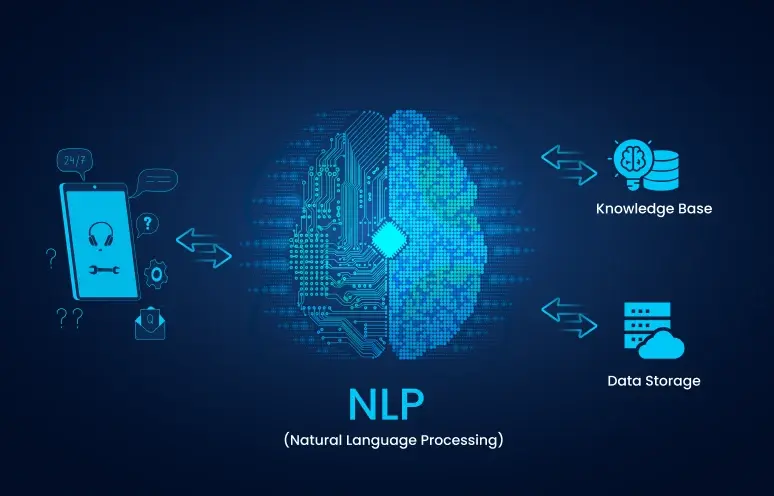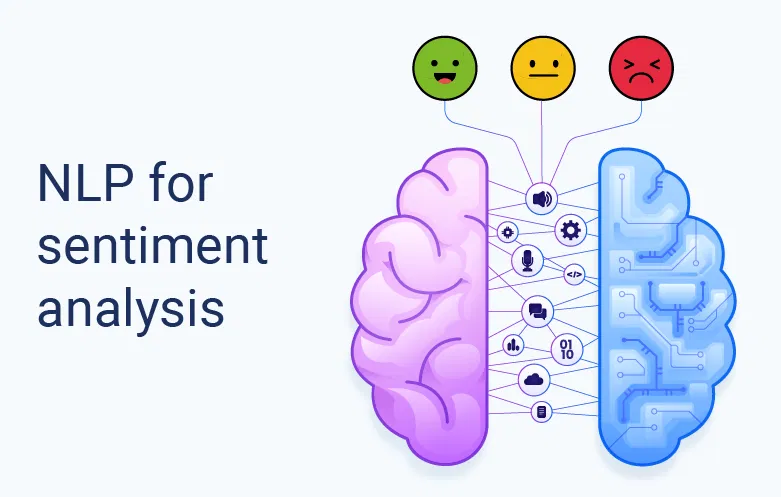According to IDC, in the not-so-distant future of 2025, a staggering 163 zettabytes of data are expected to flood our digital landscape. Yet, an astounding 80% of this data will remain unstructured, akin to having an enormous library without a catalog. This challenge is too significant for businesses to ignore, as it holds the key to untold insights and opportunities. This is where we need natural language processing (NLP) and natural language understanding (NLU), two transformative technologies that will reshape the way businesses navigate this vast sea of unstructured data.
In this journey, we’ll learn about NLP and NLU, how they can help your business in today’s data-driven world, and the challenges businesses might face if they don’t use these technologies in their apps or systems. So, let’s start by understanding these challenges.
Challenges of not using NLP and NLU in your business operations
Here are the dire challenges that your business may encounter when you neglect NLP and NLU:
- Difficulty in extracting valuable insights from unstructured customer data
- Poor understanding of customer sentiments and preferences
- Slower response times and lower customer satisfaction
- Time-consuming and error-prone manual analysis of large volumes of textual data
- Decisions based on incomplete or outdated information
- Hindered global communication due to language barriers
- Human-intensive content generation, resulting in delays and inconsistency
- Struggles in understanding user queries and delivering relevant results
- Challenges in monitoring and ensuring industry compliance
- Vulnerability to data breaches and fraud
- Decreased productivity and increased operational costs
- Lack of personalization and targeting precision
NLP vs. NLU: What’s the difference?
1. What is NLP and how does it work?
Natural language processing (NLP) is a field of AI that focuses on the interaction between computers and human language. It enables machines to understand, interpret, and generate human language in a valuable way. The benefits of NLP systems are that they break down text into words and phrases, analyze their context, and perform tasks like sentiment analysis, language translation, and chatbot interactions. Moreover, OpenAI’s advanced language models empower comprehensive text analysis, while LangChain’s specialized NLP solutions enhance data management.
NLP features –
- Data extraction and understanding – Processes unstructured text data, extracts valuable insights, and identifies entities, relationships, sentiments, and key concepts.
- Sentiment analysis – Categorizes sentiments expressed in text, such as customer reviews and social media comments, providing insights into public opinion and customer satisfaction.
- Content summarization – Automatically summarizes lengthy articles, documents, and reports, facilitating quick information consumption and decision-making.
- Language translation – Offers language translation and localization capabilities, enabling cross-border communication and market expansion.
- Enhanced customer service with NLP – Chatbots and virtual assistants understand natural language queries, improving customer support experiences and issue resolution.
- Insight generation – Analyzes unstructured data to uncover patterns, trends, and emerging issues, empowering data-driven decision-making and competitive advantages.
- Content generation – NLP applications for content generation automate content creation of product descriptions, news articles, and marketing copy, saving time and effort in content production.
- Search and recommendation systems – Enhances search engines and recommendation systems by understanding user intent and context, delivering more relevant results and recommendations.
2. What is NLU and how does it work?
Natural language understanding (NLU), on the other hand, is a subset of NLP that goes a step further. NLU not only understands language but also grasps the meaning and context behind it. It extracts entities, relationships, and intents from text, enabling a deeper understanding of human communication.
NLU features –
- Intent recognition – Identifies user intent in queries, enabling more precise and context-aware responses, improving the effectiveness of virtual assistants and customer support.
- Multilingual capabilities – Understands and processes multiple languages, making it valuable for businesses with global operations and multilingual customer bases.
- Document classification – Categorizes and classifies documents based on their content, aiding in content management, information retrieval and regulatory compliance.
- Advanced question answering – Answers complex questions, providing detailed and contextually relevant responses, benefiting customer support and information retrieval.
- Speech recognition – Extends to voice data, converting spoken language into text, enabling voice-activated systems and transcription services.
- Contextual understanding – Understands context in conversations, allowing for more correct responses in chatbots and virtual assistants.
Use cases of NLP and NLU across various industries
Manufacturing:
- Quality control: NLP is used to analyze data from equipment logs and maintenance reports to predict machinery failures. This proactive approach minimizes downtime, reduces production costs and ensures product quality.
- Supply chain optimization: NLU is employed to analyze supplier contracts and agreements, ensuring compliance and helping manufacturers make informed decisions in procurement and logistics. It aids in identifying cost-saving opportunities.
- Customer feedback analysis: NLP enables manufacturers to extract valuable insights from customer feedback, including social media comments and online reviews. This feedback informs product improvements, enhancing customer satisfaction.
- Inventory management: NLP is applied to predict consumer demand based on historical sales data and market trends. This optimization of inventory levels reduces overstocking and understocking, leading to cost savings.
- Predictive maintenance: Manufacturers use NLP to analyze sensor data from machines and equipment. It helps identify patterns indicating potential maintenance issues, allowing for timely and cost-effective repairs.
- Production optimization: NLP and NLU technologies are used to analyze production data and process logs. Manufacturers gain insights into production efficiency, enabling them to streamline operations and reduce waste.
- Market research: Manufacturers employ NLP to analyze market research reports, competitor news and customer sentiments. This helps in making informed decisions regarding product development and market strategies.
Suggested: Improving product quality with NLP and text mining
Healthcare:
- Clinical documentation: Implementing NLP in healthcare to transcribe and structure clinical notes improves the accuracy and efficiency of medical records. This ensures that healthcare providers have access to complete and organized patient information.
- Disease detection and surveillance: NLU analyzes healthcare data, including electronic health records (EHRs) and medical literature, to detect disease outbreaks and monitor health trends. It enables early intervention and public health responses.
- Medical coding: NLP automates the medical coding process, converting physicians’ notes into standardized billing codes. This streamlines reimbursement processes and reduces coding errors.
- Drug interaction detection: NLP assists in identifying potential drug interactions by analyzing patient records and medication lists. It helps healthcare providers make informed decisions and prevent adverse reactions.
- Voice assistants in healthcare: NLP-powered voice assistants, like Amazon’s Alexa for healthcare, help healthcare professionals by retrieving patient information, scheduling appointments, and providing medical references, improving productivity.
- Clinical decision support: NLU provides clinical decision support systems with the ability to understand and interpret physicians’ queries, helping healthcare providers quickly access relevant patient data and treatment guidelines.
- Healthcare chatbots: NLP-driven chatbots offer patients assistance with scheduling appointments, accessing medical records, and answering general health-related questions, enhancing patient engagement and reducing administrative burdens.
- Pharmacovigilance: NLP assists pharmaceutical companies and regulatory agencies in analyzing adverse event reports and identifying potential safety concerns for medications and vaccines.
Logistics and supply chain management:
- Demand forecasting: NLP is used to analyze historical sales data, customer feedback, and market trends to predict future demands accurately. This enables companies to optimize inventory levels, reduce carrying costs, and minimize stockouts or overstock situations.
- Route optimization: Perform supply chain optimization with NLU by analyzing weather data, traffic reports and real-time location information. This enables efficient route planning, reducing fuel consumption, transportation costs and delivery times.
- Supplier management: NLP assists in analyzing supplier contracts and agreements, ensuring compliance and helping organizations make data-driven decisions in procurement and supplier relationships.
- Voice-activated warehouses: NLP is used to create voice-activated picking and packing processes in warehouses. This increases operational efficiency, reduces errors and improves order accuracy.
- Customer support and tracking: Companies use NLU to power chatbots and voice assistants for customer support and shipment tracking. Customers can inquire about order status or delivery times, enhancing their experience.
- Inventory visibility: NLP and NLU enable companies to gain real-time visibility into their inventory across multiple locations and even within the supply chain. This reduces the risk of stockouts and ensures smoother operations.
- Supplier risk assessment: NLP analyzes vast volumes of unstructured data from news sources and supplier reports to assess supplier risk factors, helping companies make informed decisions about supplier relationships.
Finance:
- Sentiment analysis: Financial institutions use NLP to analyze news articles, social media posts, and financial reports to gauge market sentiment. Investors and traders rely on this data to make informed decisions about buying or selling assets.
- Algorithmic trading: NLP-powered algorithms process and understand news in real-time. They can execute trades based on news sentiment and events, reacting swiftly to market changes.
- Customer service chatbots: Banks and financial firms employ NLU-powered chatbots for customer support. These chatbots can understand and respond to customer inquiries, resolve issues and provide account information 24/7.
- Fraud detection: NLU applications in finance help institutions identify potential fraudulent activities by analyzing customer interactions, transaction data, and anomalies, reducing financial risks.
- Credit risk assessment: NLP assists in analyzing vast volumes of unstructured data, including financial reports, news articles, and social media, to assess credit risk for lending decisions.
- Regulatory compliance: NLP is used to monitor regulatory changes and analyze compliance documents. Financial institutions can ensure adherence to complex regulations and reduce compliance risks.
- Investment research: NLP is employed to sift through extensive financial reports and earnings transcripts to extract valuable insights, aiding investment analysts in making informed recommendations.
- Voice-activated banking: Some banks offer voice-activated services, using NLP to authenticate customers and facilitate transactions through voice commands, enhancing convenience and security.
Retail:
- Customer support chatbots: Many retailers have integrated NLU-powered chatbots into their websites and mobile apps. These chatbots can understand customer inquiries, offer product recommendations, and provide support, improving customer satisfaction and reducing response times.
- Voice assistants: Retailers use NLP to create voice-activated shopping experiences. Customers can use voice commands to search for products, add items to their carts, and complete purchases, making shopping more convenient.
- Sentiment analysis: NLP is used to analyze customer reviews, social media mentions, and feedback. Retailers can gain valuable insights into customer sentiment, identify product issues and make data-driven improvements.
- Inventory management: Retailers apply NLP to predict consumer demands based on historical sales data. This helps optimize inventory levels, reduce overstocking or understocking and enhance supply chain efficiency.
- Personalized marketing: NLU enables retailers to understand customer preferences and behavior. Retailers can then personalize marketing campaigns, recommend products, and send targeted offers, resulting in higher conversion rates and customer loyalty.
- Price monitoring: Retailers use NLP to monitor competitors’ prices and adjust their own pricing strategies in real-time. This ensures competitiveness and maximizes profit margins.
- Voice of the Customer (VoC) analysis: By analyzing customer feedback using NLP, retailers can identify trends, pain points and opportunities. This information improves product development and service enhancements.
- Loss prevention: NLP-powered systems can analyze point-of-sale (POS) data, video footage, and employee behavior to detect fraudulent activities and reduce shrinkage.
How to incorporate NLP and NLU into your business:
Integrating NLP and NLU into your existing business applications and systems can be a strategic move. To do so effectively, consider these steps:
- Assess your needs: Identify where NLP and NLU in data analysis can add value to your operations, such as customer support, content generation and more.
- Select the right tools: Choose NLP and NLU tools or platforms that align with your business objectives and technical capabilities.
- Data preparation: Ensure your data is clean, labeled and ready for analysis to achieve accurate results.
- Model development: Train or implement NLP and NLU models that suit your specific use cases.
- Testing and evaluation: Thoroughly test and evaluate the performance of your NLP and NLU applications before deployment.
- Deployment and integration: Seamlessly integrate these technologies into your existing systems and applications.
Conclusion
As we approach the era of 163 zettabytes of data, it’s clear that NLP and NLU are not just buzzwords but indispensable tools for businesses. They offer the capability to decipher unstructured data, extract insights and provide personalized experiences.
As businesses adopt NLP and NLU strategically, they can unlock a world of opportunities in the data-driven landscape of the future. To harness the full potential of these technologies and embark on your AI journey, talk to our experts at Softweb Solutions.



